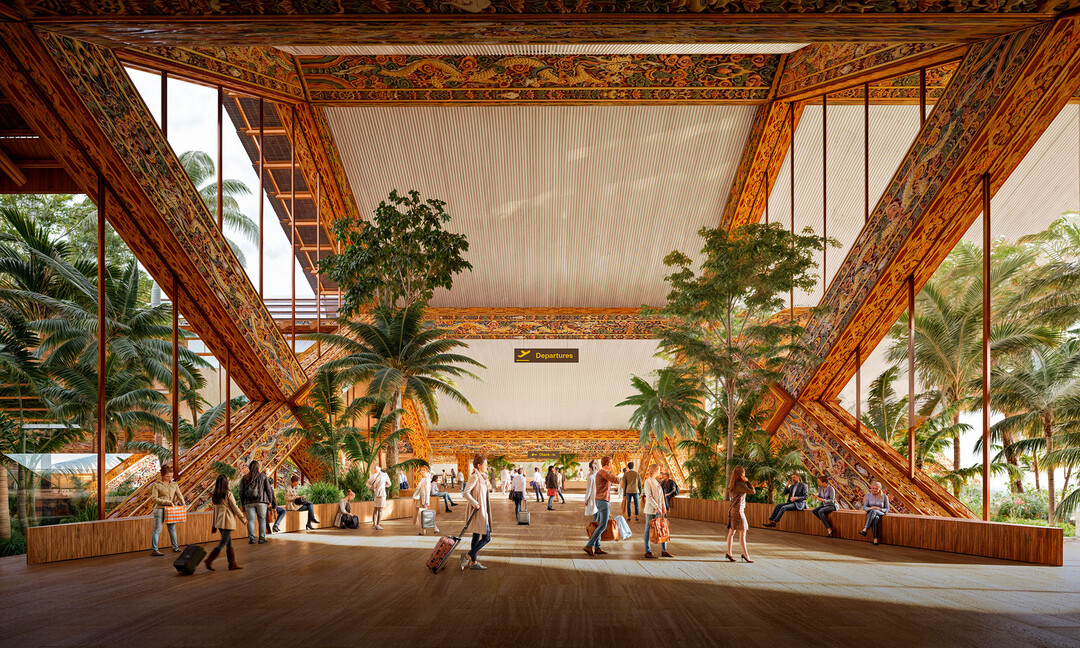
Gelephu, Bhutan – Bjarke Ingels Group (BIG) has unveiled the visionary design for Bhutan's Gelephu International Airport, a groundbreaking project poised to redefine aviation infrastructure. This airport, the nation's second international gateway, is a cornerstone of the Gelephu Mindfulness City (GMC) masterplan, aiming to harmonize Bhutan's rich cultural heritage with its aspirations for sustainable, future-forward development.
The airport's architectural language is deeply rooted in Bhutanese tradition, yet executed with cutting-edge design and engineering. Developed in collaboration with Arup, Cistri, and aviation engineering firm NACO, the design features a modular diagrid structure constructed from locally sourced glulam timber. This choice of material not only emphasizes sustainability but also reflects Bhutan's longstanding tradition of timber craftsmanship. The airport's facades are adorned with intricate woodcarvings and painted details, drawing inspiration from the "Kachen," a revered wooden pillar that symbolizes both structural strength and spiritual significance in Bhutanese architecture.
"The Gelephu Airport is designed as a portal to Bhutan, a country renowned for its commitment to Gross National Happiness and environmental stewardship," said Bjarke Ingels, founder and creative director of BIG. "Our design blends traditional Bhutanese architecture with modern engineering to create a sustainable and welcoming gateway."
Strategically located near the Bhutan-India border and the Paitha River, the 68,000-square-meter airport is projected to handle 1.3 million passengers annually by 2040, with estimates soaring to 5.5 million by 2065. With a planned capacity of 123 flights per day, the airport is set to become a pivotal aviation hub for the GMC, aligning seamlessly with Bhutan's long-term development objectives.
A highlight of the airport's design is its modularity. The independent timber frames allow for easy disassembly and expansion, ensuring the airport can adapt to future growth and evolving needs. This flexibility is crucial for a nation that prioritizes sustainable development and resource efficiency.
The Gelephu International Airport will be showcased at the 2025 Venice Architecture Biennale, where an exhibition will feature a timber diamond piece that mirrors the airport's distinctive façade. This installation, crafted in real-time by both a Bhutanese artist and a robotic machine, will highlight the harmonious blend of traditional craftsmanship and technological innovation that defines the project.
Environmental sustainability is a core principle of the airport's design. Bhutan, a nation celebrated for its carbon-negative status, has mandated stringent environmental standards, which BIG has meticulously adhered to. The airport incorporates photovoltaic panels on the roof to generate renewable energy, passive climate-responsive elements to regulate temperature, and extended eaves to provide shade and weather protection. The wooden structure itself naturally regulates humidity, while courtyards and ventilated roofs promote natural airflow.
The terminal layout is designed to enhance the passenger experience, featuring clear wayfinding, intuitive circulation, and an abundance of natural light. The "Forest Spine," a central courtyard within the terminal, brings Bhutan's rich biodiversity indoors. This green oasis includes indigenous flora, a treetop walkway, and serene spaces for relaxation, meditation, and wellness activities, fostering a deep connection with nature.
Recognizing the importance of seamless connectivity, the airport will serve as Bhutan's first inland mobility hub. It will integrate public transportation options, including trackless trams and buses, facilitating easy access to Gelephu's revitalized town center and other regions of the country.
The Gelephu International Airport, slated to open in 2029, is poised to become a transformative gateway to Bhutan, seamlessly blending cultural heritage with forward-thinking infrastructure. It exemplifies BIG's commitment to creating architectural solutions that are not only visually stunning but also deeply rooted in sustainability and cultural context.
BIG's involvement in the Gelephu project underscores its global reputation for innovative and culturally sensitive architecture. The firm's recent projects, such as the design for Kosovo's first opera house with its photovoltaic roof and the comforting Sankt Lukas Hospice in Denmark, further illustrate its commitment to creating spaces that enhance both human experience and environmental sustainability. Their design of the Mandarin Oriental Residences in Abu Dhabi’s Saadiyat Cultural District also demonstrates their ability to create modern structures that complement and enhance their cultural surroundings.
[Copyright (c) Global Economic Times. All Rights Reserved.]






























